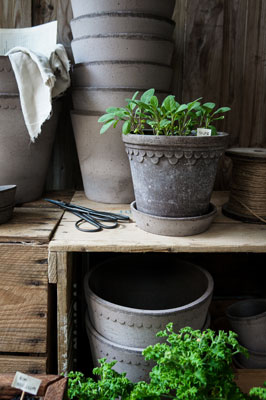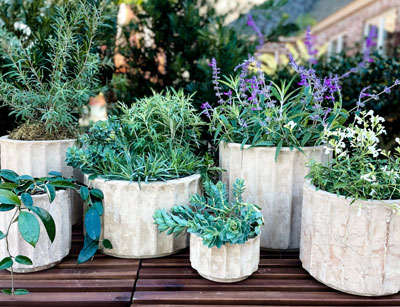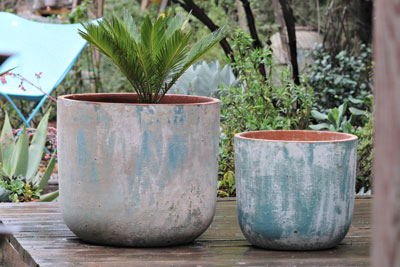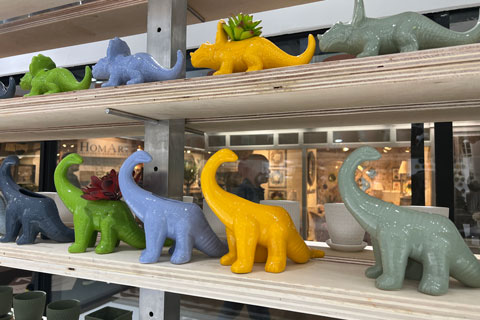2/1/2023
Finding the Right Mix
Jennifer Polanz

There are so many ways to buy containers, from trade shows, distributor shows and markets to ordering direct and finding small batch potters and other artists to make unique offerings.
Pictured: The Copenhagen style, inspired by pottery from the Royal Danish Castle Fredensborg in the 1860s, by Bergs Potter.
With all the product out there (and there’s a lot—I just got back from Atlanta’s AmericasMart and there are showrooms filled to the brim with containers and décor), how do you know what to get and how much? Buyers have been navigating these challenging waters for years, and that was before a huge surge in consumer demand followed by supply chain woes followed by all that product finally being delivered. I’ve talked to retailers who said they ordered container-loads in 2021, only to finally receive it at the tail end of 2022.
Here are a few suggestions for how to create the right assortment this year, as well as some strategies for retail sales and trends for this year and beyond.
Watch Your Market
Your local housing market can tell you a lot about what kinds of containers you should look to stock, said Kevin Xu, owner of Pacific Home & Garden, a pottery manufacturer and wholesaler. Kevin not only has the pottery business, but he also has two retail locations called Jackalope Pottery & Plants, one in North Hollywood and the other in Emeryville, near San Francisco, California.
“I would say because of the slowdown in the real estate market, that’s probably affecting the trends,” he said. “Especially the larger-sized containers that have been popular for the last two years. I think in my experience the larger size containers are connected to the real estate market. When real estate is doing well, the larger containers are in higher demand.”
If a garden center is in an affluent area or somewhere where newer developments are still being built, they should look to carry some of those larger pieces for architectural appeal. However, the key is getting them, as there were fewer factories producing them, he added. If the retailer can get them, though, they won’t have much competition by way of the big box stores, as they’ve struggled to get the larger sizes.
Urban vs. Suburban
It also depends on whether you’re in the suburbs or an urban setting. If you’re more urban, medium-sized and smaller containers are the way to go because of space constraints, and Kevin said neutral colors play better in the cities. Out in the suburbs, you can carry some larger pieces blended in with medium and smaller sizes, with a mix of conservative colors like blue, white and blue-green.
 Pictured: Anamese’s take on Greek chic, the Pilar’ Collection, is available as a bowl, a planter and a vase.
Pictured: Anamese’s take on Greek chic, the Pilar’ Collection, is available as a bowl, a planter and a vase.
He added that rustic looks continue to be popular, particularly for larger size containers, and that trend should continue for another couple of years. He carries pottery that has the patina of terracotta, but isn’t actually made of terracotta, in the style of aged Tuscany, and they’re sold out of it.
When it comes to color trends overall, Kevin said he’s seeing the matte black trend slowing down, but white continues to sell well. That deeper, darker blue color is coming back into the mix, too. Mainstream colors are coming back into the mix, including traditional blues, greens and reds. He especially sees yellow trending for 2023. The colors tend to be in the mid-size containers, while larger containers are still more neutral.
Whimsical …
Who doesn’t love a planter shaped like a sloth, dog or even Groot from the Marvel movies? Everyone has got their version of whimsy and it’s easy to get swept away by all the cute planters available now. But how much is too much?
“I’m debating that myself right now,” Kevin admitted. “I would say don’t go too crazy on it—a little bit goes a long way.
“When I’m sitting down to buy it I’m still not buying a lot of it. I look for something where I can create an endcap with that, a small collection.”
He gravitates toward geometric designs and patterns, too, which can appeal to customers for longer than a sculpted piece that may be hit or miss. In the end, though, you know what your customers want, and if they’re crazy for dogs (and you can tell this by all the dogs coming into your shops), then the dog planters may be the way to go.
 Pictured: This Aegean finish from Pacific Home & Garden is popular all over the country, said owner Kevin Xu. It started on the West and East coasts, and the popularity continued inland.
Pictured: This Aegean finish from Pacific Home & Garden is popular all over the country, said owner Kevin Xu. It started on the West and East coasts, and the popularity continued inland.
And the whimsy doesn’t just appeal to adults; it can draw the kids in, as well. Chive, a company that offers modern and contemporary designs for pottery, vases and terrariums (and also has its own retail shop in Toronto) just introduced a new line called Dino, with two types of dinosaur planters. They cleverly merchandise the planters on the lowest shelves in the store, waiting for the kiddos to grab them and ask their parents to buy them.
“The kids always win. We sell a lot of Dinos. A lot a lot,” the company said.
… or Traditional
When it comes to traditional, you can’t get much more classic than clay pots and that’s what Bergs Potter specializes in. I first came across this company at Terrain at Styer’s during the 2021 Garden Center Group Fall Event. The garden center featured an elegant and striking display of the pottery, which is designed in Denmark and hand-crafted in Italy.
I came across them again at AmericasMart in Atlanta in the temporaries, where they were introducing new designs and showcasing their classic lineup. They are all made from Galestro clay, which makes the pots sturdy and frost-resistant.
I

nspiration From Afar
The crew at Anamese, a woman-owned company that sources hand-made pottery, often travels to France to find out the latest in design trends. It’s been a hot minute since they’ve been able to get there due to the pandemic (2019), but they were able to get to the Maison et Objet design trade fair in the fall.
Pictured: If you’re looking for fun, you can find it in the new Dino series from Chive.
When they returned, they uploaded a blog post with design trends galore, including a few key themes:
• Outdoor spaces will continue to be popular, with design becoming an important element
• Biophilic design will be important for interiors, incorporating natural light and indoor plants
• Sustainable materials and designs will continue to be on trend
Color palette-wise, here’s what they saw: “Rich emeralds, vivid whites, rustic sages and big cobalt blues are expected to cool off the recent dominance of earth-tones. Warmer colors will be brighter: burnt oranges, intense reds, rich terracottas, blushy mid-tones.”
Remember when style expert and guest buZZ! e-newsletter editor Stacy Sirk noted fermented food colors would be trending this year? That’s those warmer colors Anamese is talking about.
What About Availability?
That was the No. 1 question last year, and while the supply situation has definitely changed, there are still challenges. For example, all the pottery that’s coming in now will still reflect increased costs of production, as well as increased freight charges. Retailers can expect those to go down late spring.
And while China hasn’t been as affected, as of press time, by factory shutdowns on the pottery side (that’s more on the electronics side), there have been issues in Vietnam with factories having difficulty sourcing wood to burn for the kilns, Kevin said. Those are the ones that produce the larger-sized containers, which is why they’re harder to source for mass merchants.
Kevin noted retailers should still consider playing it safe. “I would still think they should plan it earlier,” he said of pottery orders for 2024. “Because even though the supply chain is easy now and things seem more normal, production of the larger sized containers is still pretty difficult and the supply is still limited.
“If you want to have the best collections landing in your store in a timely manner, they should still plan it earlier.”
The regular sizes won’t see problems with supply, he added, but he suggests retailers visit trade or distributor shows to see and touch the containers before buying.
“There are a lot of variations and it helps to understand the product better,” he said.
A Tip for Selling All That Pottery
You’ve ordered, you’ve received and now you have a ton of pottery. Kevin Xu, who owns both a pottery company and two retail garden center shops, has noticed a trend: pre-planned container gardening. He pots of up mixes in lighter weight containers for his North Hollywood customers, who come in and order multiples (upwards of 15 or more) for delivery. Once some start looking a little rough, they’ll order more for replacements.
It’s a great way to sell the pots and the plants at a premium, keep customers happy and keep them coming back for new looks. GP